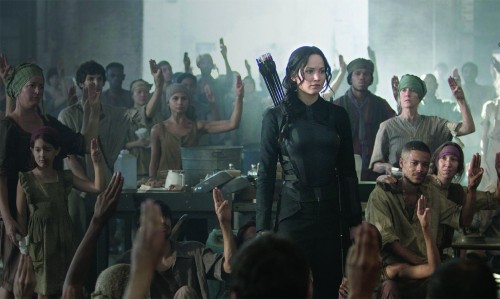 KATNISS EVERDEEN RETURNS to the silver screen in Part 1 of the final Hunger Games movies. The first of the two installments suffered due to a missing half, leaving the audience with major cliff hangers.
KATNISS EVERDEEN RETURNS to the silver screen in Part 1 of the final Hunger Games movies. The first of the two installments suffered due to a missing half, leaving the audience with major cliff hangers.While filled with fleshed out characters and absolutely enthralling plot points, The Hunger Games: Mockingjay, Part 1 falls victim to the “Part 1 of 2” problem that is all-too-common in today’s movie scene. An unnecessary split into two films hinders the movie’s ability to provide a full conclusive story. The audience is left with literally half of a movie, with no resolution or character growth at the end. Despite the unneeded split, however, the film does a wonderful job further pushing its fleshed out characters and unique plot elements.
One of the many things I enjoyed about The Hunger Games: Mockingjay, Part 1 was the exceptional dynamic between Peeta and Katniss. At the end of the previous Hunger Games movie, Peeta was captured by The Capital. Throughout this movie, Peeta is interviewed on live T.V. by Caesar Flickerman, the face of The Hunger Games within The Capital. Caesar elicits responses from Peeta that shun the districts’ rebellion and generally are not friendly to the districts’ cause. This brings up many interesting questions for both the characters within the story and for the audience. Does Peeta truly mean these things he’s saying? Is he just saying it to save his skin? Is he brainwashed? Katniss believes that Peeta is not at fault and that The Capital is forcing him to say these things. Despite her optimism, many people within the rebellion see his words as “pro-capital,” and want him gone. As a viewer, I was genuinely intrigued to see how this situation would conclude.
Another element of The Hunger Games: Mockingjay, Part 1 that I particularly enjoyed was the internal struggle of Katniss throughout the film. She has become the figurehead of a war she wants no part in. Katniss just wants to run away from it all and let those who are capable handle it. However, through an unprecedented series of events, she has become what no leader can force themselves to be: a symbol of hope. People from all around Panem look to Katniss as the one who shot the arrow, the one who can stop The Capital, and the one who can unite the districts. Katniss is forced to go along with this role because the only way to save Peeta from The Capital is with the assistance of District 13. The only way District 13 will agree to help her is if she agrees to be their figurehead. Watching Katniss struggle through this dilemma was a unique viewing experience and a pleasure to watch throughout the film.
My criticisms of this film are minute but numerous. As stated before, there was no reason to split the film into two parts. It was just a marketing scheme for extra box office earnings. Another problem that I noticed was that Katniss didn’t seem to do anything during this film. The entire extent of her action was shooting one arrow to take down two airplanes. How am I supposed to root for a protagonist that appears to sit back and let the people around her do the actual work? The last problem I had with this film was the entire “in-action” dynamic they pushed within the first half of the film especially. Their theory was that Katniss needs to be put into danger in order to get good propoganda footage. However, this just came off as camera awkward and forced. They essentially went out into the districts and caused the destruction of a hospital just to get Katniss heated. Although I understand the general premise of the idea, I can’t help but think that they went a bit too far for some extra footage. In the end, it seems like an unnecessary plot point that they included in order to stretch for a second film.
Overall, I enjoyed the movie experience of The Hunger Games: Mockingjay, Part 1. Some fatal flaws held the movie back as a whole, but many interesting elements kept me interested from start to finish. Despite this movie’s imperfections, I am definitely excited for the final movie of this franchise.
